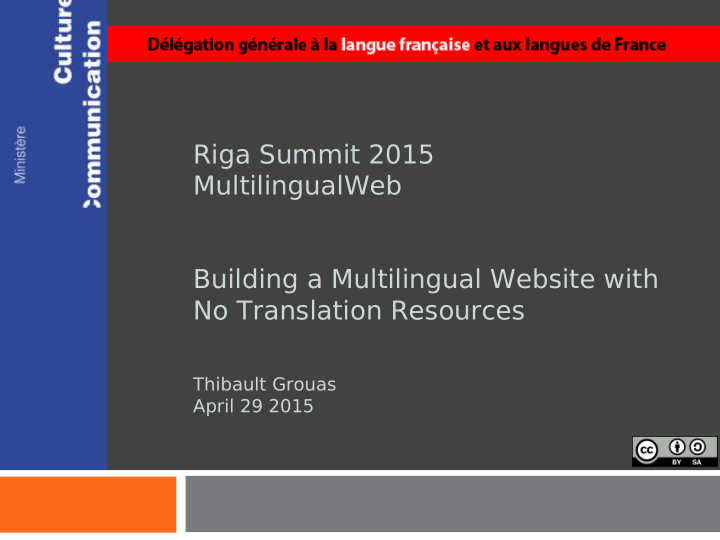



Riga Summit 2015 MultilingualWeb Building a Multilingual Website with No Translation Resources Thibault Grouas April 29 2015
1. Technology and digital policies for languages in France Delegation for french language and languages of France is responsible for the national linguistic policies It is part of the french Ministry of Culture and Communication Covers all languages spoken in France including French, regional languages and foreign languages. There are about 75 languages historically spoken in France, called « Languages of France » (most are regional languages) We actively promote multilingualism , which is the language of Europe The Delegation has a team dedicated to digital environment Digital and technologies appear to be a major issue for language policies today Linked Open Data is a new opportunity for providing multilingual web services and applications
2. The Sémanticpédia partnership On November 2012, a major partnership was set-up between french public authorities, technology experts and a knowledge community : French Ministry of Culture, INRIA and Wikimédia France
3. Sémanticpédia and DBpédia.fr Sémanticpedia links together research (Inria), Culture (Ministry of Culture) and Web 2.0 (Wikimédia France) • Inria brings its technical expertise of the web and linked data • Ministry of Culture has a unique expertise on Culture • Wikimedia France is the largest provider of cultural content on the web, with more than 25 million visitors per month in France Objectives of the partnership : to mutualise expertise and research to imagine new connections and technologies for Culture The partnership will be reinforced in late 2015 to integrate public cultural institutions like Musée du Louvre , Monuments historiques or Bibliothèque nationale de France The first project was Dbpédia.fr , a Wikipedia extraction conforming to linked open data standards based on the Dbpedia.org project, freely available through a SPARQL endpoint since 2013.
3. Experimenting with DBpédia.fr Ministry of Culture conducted several experiments with DBpédia.fr to demonstrate the potential of linked data with multilingualism Firsts experiments : HDA-Lab (2013) : hdalab.iri-research.org. 3000 articles • related to Culture available in 6 languages Museosphere.net (2013) – a museum search web service • available in 9 languages We organised a competition on 2014 to help developing cultural projects based on Dbpédia.fr. Winner for « linguistic » award : CROTOS Lab • http://zone47.com/crotos/ , browse and tag famous paintings in 33 languages.
4. The Joconde Lab project The experiment took place in 2013-2014, with JOCONDE database form Ministry of Culture. JOCONDE contains about 300,000 images of various works of art displayed in french museums. The objective was to allow full navigation in the database with 14 languages (those directly integrated into Dbpédia.fr), with no translation, including 4 regional languages . Project started June 2013 with a partnership with Institut de recherche et d’innovation du Centre pompidou 8 months later , The JocondeLab website opened with 300,000 illustrated files of works of art available in 14 languages Only half a page of interface texts was translated for the project (menus, buttons...) The project won a « Data Intelligence Award » 3 months later It is a major step towards linguistic diversity
5. How does the magic work ? Images Wikipedia Dbpédia.fr SPARQL Descriptions Requests Wikipédia keywords Joconde Lab Joconde Lab RDF SPARQL Requests Back-office Links Public website Joconde keywords Images JOCONDE Other Classic SQL metadata Requests
6. Demonstration Joconde Lab Online demo http://jocondelab.iri-research.org/jocondelab Offline demo file:///E:/Anim_Jocondelab/jocondelab.htm
Joconde Lab front-office Homepage (french)
Joconde Lab front-office Search : « Fleur » (french)
Joconde Lab front-office Responsive design optimised for mobile use.
Joconde Lab front-office Search results for « Fleur » (arabic). Note that texts are aligned to the right
Joconde Lab front-office Navigation with the map tool : results for « Lorraine » (french)
Joconde Lab front-office Navigation with the map tool : results for « Lorraine » (russian) Descriptive texts come from Wikipedia through DBpédia.fr
Joconde Lab front-office Navigation by keywords (artists) in portuguese Images and texts come from Wikipedia through DBpédia.fr
Joconde Lab front-office Detail of a file from the Joconde Database (basque) Linked tags appear in blue and are automatically translated Field names were manually translated It is possible to add new keywords with the multilingual contribution tool below.
Joconde Lab back-office The back-office is a simple tool to facilitate and help the linking process between keywords from DBpédia and JOCONDE. All proposed matches are manually validated by Ministry of Culture
Joconde Lab back-office Detail of the Joconde thesaurus 87 000 keywords were linked during the project by 2 persons during 3 months (total 6 months work). 95 % of Joconde keywords were found in DBpédia.fr which is pretty good
More projects to follow ! Thibault Grouas thibault.grouas@culture.gouv.fr @tgrouas
Recommend
More recommend